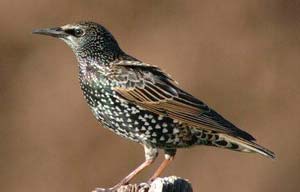QUICK TIPS: The North American Bluebird Society recommends that nestboxes from Eastern and Western Bluebirds have a 1 1/2″ diameter entrance hole, while Mountain Bluebird nestboxes should have a 1 9/16″ hole. Slot box and oval hole dimensions are different. More Info
In 1970, Dr. Lawrence Zeleny wrote a book in which he established a standard nestbox design: a top opening box with a 4-inch by 4-inch floor and a 1 1/2-inch entrance hole. But the dimensions and specifications of nestboxes for various small cavity nesters continue to be the subject of great debate.
The 1.5″ nestbox hole did not prove ideal for the Mountain Bluebird (MOBL). In the late 1970s, Art Aylesworth of Montana and Duncan Mackintosh of Alberta found that occupancy of Zeleny-style nest boxes was low. Duncan noticed that the feathers on the shoulders of some MOBL’s using the boxes appeared worn or broken. Art and Duncan learned that the Al Perry of Boise, Idaho, and the Brinkerhoffs in Washington were having much higher rates of occupancy with larger entrance holes.
 Myrna Pearman noted that “By 1981, almost all the boxes in Montana, Alberta, and the panhandle of Idaho had the larger openings.” Duncan was using a 1 5/8 inch hole, and Art used 1 9/16 inch. But in 1984, starlings were reported using boxes equipped with the 1 5/8-inch hole. Duncan and Art found that putting 1 9/16-inch patches over the holes excluded starlings. Western and Mountain Bluebird ranges overlap in some areas. They also learned that, while Western Bluebirds did not appear to require the larger hole, they seemed to prefer it over the 1 1/2 inch.
Myrna Pearman noted that “By 1981, almost all the boxes in Montana, Alberta, and the panhandle of Idaho had the larger openings.” Duncan was using a 1 5/8 inch hole, and Art used 1 9/16 inch. But in 1984, starlings were reported using boxes equipped with the 1 5/8-inch hole. Duncan and Art found that putting 1 9/16-inch patches over the holes excluded starlings. Western and Mountain Bluebird ranges overlap in some areas. They also learned that, while Western Bluebirds did not appear to require the larger hole, they seemed to prefer it over the 1 1/2 inch.
However, Bergmann’s rule pointed to a potential problem. The rule is that birds living in warmer climates tend to have smaller bodies than their colder climate relatives. Therefore, smaller southern starlings might be able to, or even end up getting evolving to be able to enter a 1 9/16 inch hole.
However, Art was unable to find documented cases of starlings using the 1 9/16 inch hole UNLESS it had been enlarged (e.g., by flickers or squirrels.) There WERE reports of dead starlings stuck in a 1 9/16 inch entrance hole. A 1977 Lehmann study with 10 captive starlings found that two were able to escape out of a box with a 1 9/16-inch hole, but captive starlings may not be as large as an egg-bearing wild bird.
NABS now recommends that the larger 1 9/16″ hole be used wherever there are Mountain Bluebirds, or wherever the range of the Mountain overlaps with that of Eastern or Western Bluebirds.
See more information about hole size entry tests for starlings, bluebirds, and house sparrows.
Sources and More Information
- Biology: Eastern Bluebirds | Mountain Bluebirds | Western Bluebirds
- House Sparrow Biology
- Starling Biology
- Bergmann’s Rule
- Hole Size Experiments
- Hole reducers/restrictors
- Aylesworth, A. 1984. Large box openings can be curse or blessing. Sialia. Vol. 6, No. 4
- Lehmann, D. 1997. Control tests to determine if European starlings can pass through various hole sizes. Sialia Vol. 19, No. 4
- Pearman, Myrna, 1999, The Great Entrance Hole Debate, R “Bluebird,” (Spring 1999) Journal of the North American Bluebird Society.
At the moment, we’re arguing over whether bluebirds use “bird houses” or “nestboxes” and whether “nest boxes” is one word or two!
– Myrna Pearman
